"Two of my sheep were skinned... there was no actual body left. Just the skin. It was so tidy – it was like someone had been there with a knife and skinned them.
“I’d never seen anything like that before. Only the head was left.”
Wondering what sort of animal could be capable of such precise butchering, Ceredigion farmer Johnathan Davies contacted Dyfed-Powys Police in February and claims an officer told him a big cat could have been responsible for killing his yearling ewes.
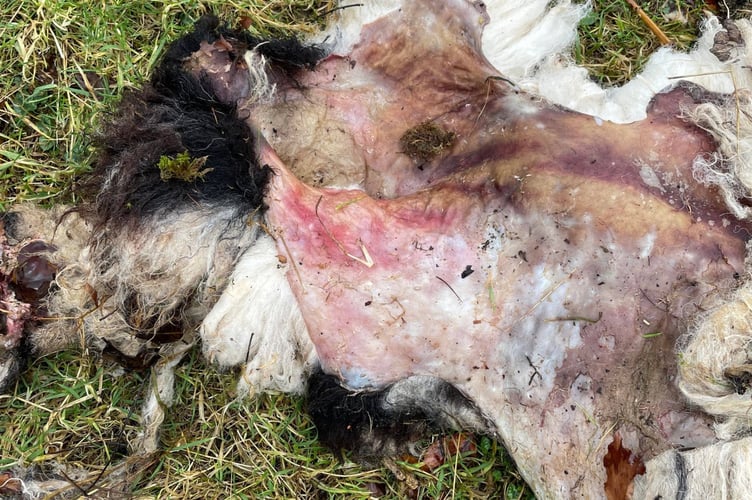
Recent gruesome sheep killings and suspected sightings have reignited a debate about whether a population of mysterious predators exists in the Cambrian Mountains – and whether the animals could be a ‘danger to the public’, in the words of an ex-police officer the Cambrian News spoke with.
They have also sparked renewed interest in myths and folklore about a beast, or a population of them, lurking in the forests of Ceredigion.
But there is evidence too. In 2007, scientific analysis of bite marks on bones from sheep carcasses found in the Aeron Valley found big cats were responsible.
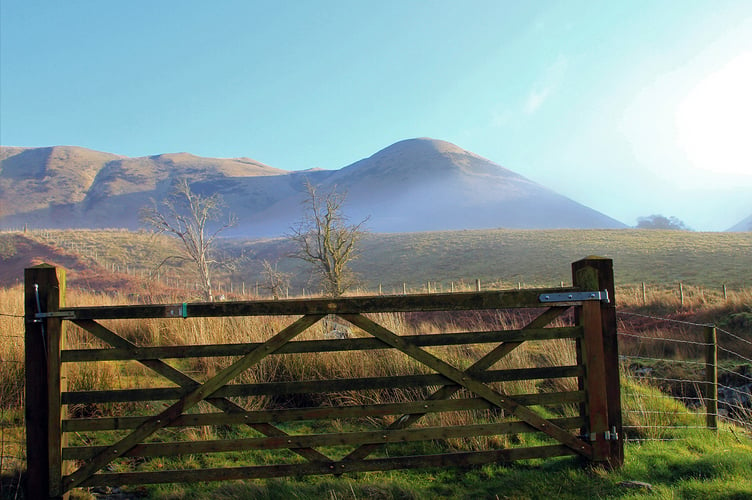
In June 1981, 12 sheep were slaughtered by an unknown creature in the tiny village of Pontrhydfendigaid - known locally as Bont - which sits to the west of the Cambrian Mountains range stretching across Ceredigion and Powys.
Veterinarians from the UK Ministry of Agriculture, as it was then, are said to have released findings that whatever had killed the livestock must have been a ‘great deal more powerful than a fox or a dog’.
Around that time, there were also a spate of reported sightings of an abnormally large black cat - reminiscent of a puma or a panther - roaming the surrounding countryside.
And so, the legend of the ‘Beast of Bont’ was born.
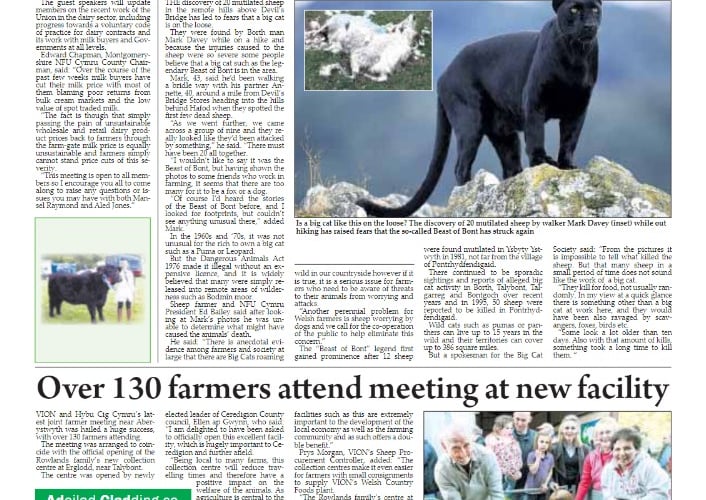
But after 42 years, sightings of such an animal and sheep being killed in mysterious and brutal circumstances remain remarkably routine in rural Ceredigion.
And not only in Ceredigion but in Gwynedd and the north too. North Wales organisation Puma Watch — formed because of the high frequency of big cat sightings in the region — has a database of incidents and photos.
It says there has been nearly 50 sightings in north Wales since March 2020.
The Cambrian News spoke with several farmers whose sheep had recently been ‘disemboweled’, ‘eviscerated’ or dragged up hillsides – while one even found a calf’s leg hanging from a tree.
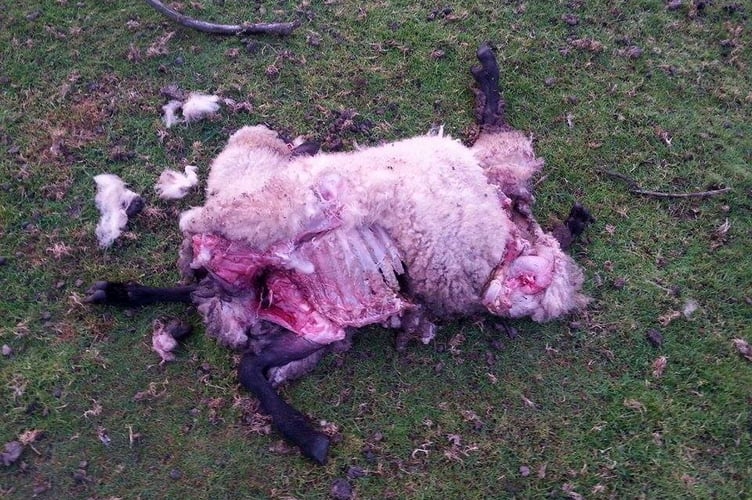
In the more mountainous towns and villages of the region, many residents believe it is plausible that an indigenous population of big cats exists. Such a theory has also recently been given credence by Welsh BBC naturalist lolo Williams. Though years earlier he is said to have dismissed the idea they could be panthers, a critically endangered species.
But in response to questions from the Cambrian News, authorities including Dyfed-Powys Police have been tight-lipped about the possibility such powerful predators are at large and on the prowl in the region.
Perhaps this is to avoid alarmism – and the force can’t be blamed for that.
But a spokesperson did not deny there exists a specific reporting log dedicated to ‘big cat sightings’ - something multiple farmers claim they have been informed about by police. Mr Davies claims an officer told him about a 32-mile corridor between locations in Carmarthenshire and Ceredigion, between which the big cats migrate during the year.
The police did also issue some guidance for those who have seen ‘the animal’ and are appealing for the public to photograph it and report sightings.
However, there is growing speculation that there may not be just a singular Beast of Bont, but rather multiple Beasts of the Cambrian Mountains – or even Wild Cats of Wales, like their Scottish counterparts.
“At the weekend I was washing up and looking out of my kitchen window, and I thought to myself, ‘that’s a bloody big cat’,” Suzanne Hill of Penuwch - 12 miles from Pontrhydfendigaid - told the Cambrian News.
“It played on my mind, and I thought about it and looked at the perspective, and I realised I shouldn’t have been able to see a cat all that distance away with such clarity.
“It was unmistakably feline, jet black and it had a long black tail carried out the back. It was about the height of a Labrador - but much longer.”

Each of those who claimed sightings to the Cambrian News, including Ms Hill, said they initially felt silly believing such a thing – until they heard others who’d had the same experiences or could tell the stories of people who had seen the same creature.
“I posted about it on Facebook with a picture of a panther from Google, and I didn’t expect the response I got – I expected to be ridiculed,” she said.
“I didn’t expect the depth of belief, the examples, the stories, the recollections of dates and places and people and names.
“We could be talking about a new indigenous species. The wild cats of Wales.”
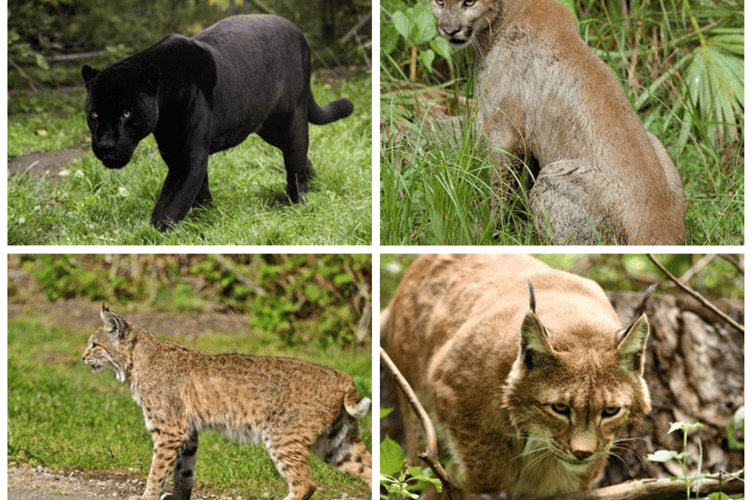
Ms Hill, who moved to the village from Surrey in 2021, saw the large black-panther-like cat twice in little over 48 hours and recently one of her ‘large, athletic and flighty’ yearling ewes - worth to farmers around £100 - was ‘eviscerated’.
“There was bowel juice everywhere,” she said. “She had been opened right up and one leg joint, like a lamb roast, had been eaten to the bone.”
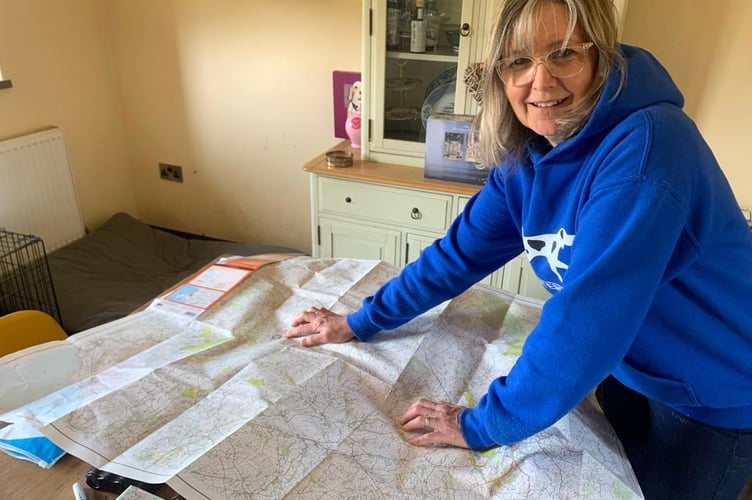
National media interest in the Beast of Bont peaked once more in 2012 when 20 sheep were ‘sickeningly’ butchered in the hills around Ponterwyd, near Devil’s Bridge.
The Cambrian News has received images of similar grizzly sheep killings.
Another farmer from near Penuwch told the Cambrian News she had gone to feed the sheep one morning in 2015 when they refused to come out – and the horses, well used to dogs and foxes, were snorting and appeared visibly frightened of something.
“One of my ewes had been sliced open from her chest all the way along her abdomen to her rear end - and the heart had been taken out,” she said.
“She was still warm to the touch when I put her in the wheelbarrow. She had been dragged 20 feet from where she was killed. I found her intestines discarded by the tree nearby.
“She was an active healthy yearling ewe and was completely fine the night before.
“Our next-door neighbour also had a couple of ewes taken on the same night. People have said they think the sheep kill was a fox or a dog.
“But the ewe was killed quite quickly. I believe it was a big cat.”
The farmer says she spoke to a friend of hers who is a doctor of ecology, and they said the method of killing looked consistent with a big cat.
Mr Davies - whose farm near Ponterwyd backs out onto Cwm Rheidol - told the Cambrian News further details about his sheep and the phone calls he had with the police in February.
“I phoned a few farmers and a friend in Devil’s Bridge, and she said she’d been having trouble for about 15 years. She said she loses about six sheep a year,” he said.
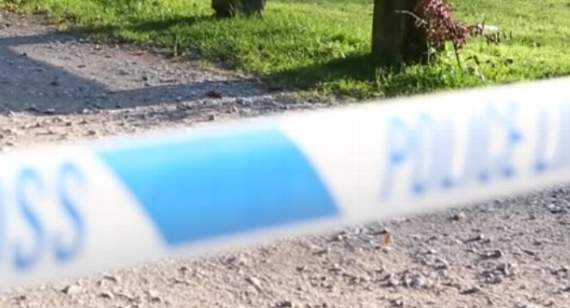
“She had inspectors at her farm, looking at these carcasses, and they told her it was a cat.
“She told me to call the police and report it, so when I called up, I said to the policewoman, ‘you’re going to think I’ve lost the plot here’.
“But she said I can see it all on the log that there are loads of reports and it’s always happening.
“She told me a woman in Carmarthen had lost eight (sheep) in the space of a week - and she had put remote cameras up to try and catch a glimpse of it.”
Mr Davies said an officer who called back after the initial report told him a big cat was likely to be responsible for the brutal killing of his ewes.
The policewoman asked whether the butchering happened near a stream, which Mr Davies said it had. The officer added that the creatures follow waterways – and would have emerged out of the woods.
The officer allegedly told Mr Davies that the cats spend the winter in the Brechfa Forest in Carmarthenshire and travel up to Myherin Forest in the mountains behind Devil’s Bridge for summer. She added that this was why a lot of farmers near Mr Davies lose sheep in the Autumn or the Spring - because the cats are making a 32-mile migration, as the crow flies, between the two places.
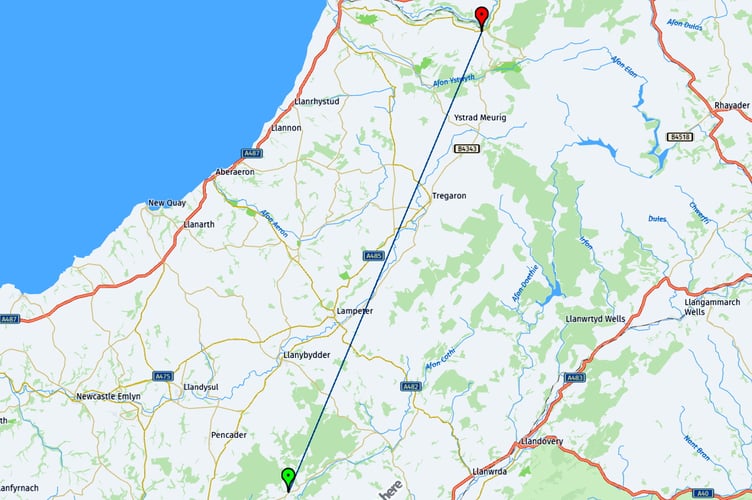
She went on to explain that people discarded their exotic pets, many releasing them into the wild, before the Dangerous Wild Animals Act was passed in 1976 – to avoid the costs associated with licensing. Mr Davies added the officer told him the animals are still around because they will have been breeding.
Before hanging up, he claims the officer warned him that if he saw a big cat, ‘don’t look at it in the eye’ - to avoid threatening it. Most of the time the animals will run off if you turn your back, she said.
A Dyfed-Powys spokesperson claims this is an inaccurate reflection of what was logged by the officer – but Mr Davies stands by his account and was shocked the police contested it.
A retired Dyfed-Powys Police officer, who served on the force for 25 years, told the Cambrian News she responded to several reports in which sheep were killed in strange circumstances – and carcasses were tested by experts.
“Yeah, we went to physically examine sheep – photograph them and note the injuries,” she said.
“It can be quite a distressing situation for farmers.
“There was all this talk (about big cats) especially because the injuries to the animals were quite severe.
“So, we were always mindful that there may have been something there, but they used to have marksman going out just in case.
“I would think if a cat had been spotted, that would be when (marksman would go out) - in case the animal posed a danger to the public.”
There does seem to be some degree of secrecy about the operations the officer describes. Police were unable to provide us with details – such as how many reported sightings in Ceredigion have been logged. We have submitted a Freedom of Information request asking for those figures.
A man who wanted to remain anonymous said he met a man who worked as a marksman for Dyfed-Powys Police who claimed he’d ‘removed’ several big cats – whose bodies are then disposed of by the force ‘during complete darkness’.
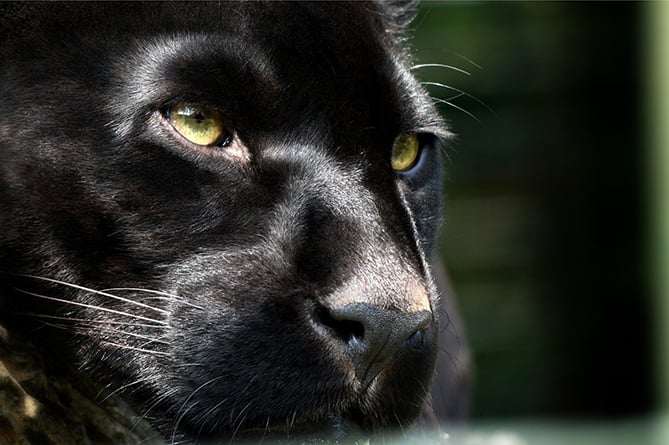
A Dyfed-Powys Police spokesperson told the Cambrian News: “We wouldn’t be able to confirm any suspected big cat sightings at this time.
“We don’t have anyone specifically trained in shooting big cats, however, our firearms officers are trained in animal destruction for animals that are suffering or dangerously out of control.
“Where sightings of suspected big cats are received these are then reported by the police to the Welsh Government.”
The Cambrian News has asked Dyfed-Powys Police for more details about why the Welsh Government is informed of sightings – and is awaiting an answer.
A Welsh Government spokesperson said: “There is no requirement to inform the Welsh Government, however, any report received from the public of alleged sightings of, and alleged attacks by, big cats on livestock in Wales are investigated.
"Any threat to human life is the responsibility of the Home Office and such concerns should be referred to the police.
"All reported sightings and incidents are taken seriously and investigated thoroughly but no hard evidence has been discovered proving the existence of big cats in the Welsh countryside.
"Most attacks on livestock are carried out by native predators such as foxes, or by dogs.”
But Dyfed-Powys Police clearly takes the possibility of big cats very seriously and did issue some ‘simple guidelines people should follow’ - where the spokesperson describes a singular ‘animal’, much like those who describe a ‘beast’ of Bont.
The spokesperson said: “Don’t approach the animal and don’t leave any food out for it as this could encourage it to come closer to your home.
“Report the sighting to the police and give them as much information as you can, such as a detailed description of the animal, where it was seen, how far away it was, and the direction it was travelling in.
“Any animals which have been killed should be kept so they can be examined.
“If it’s possible to get a photograph of the animal without putting anyone in any danger, then that too would be useful.”
A recent post on Facebook contains scores of accounts of people who have seen a large black cat – and theories as to why they are on the prowl in Wales.
It appears to be accepted that people in Llandewi Brefi, Aberarth and someone near Towy Forest in Carmarthenshire used to own big cats and, rumour has it, released them into the wild once licensing laws were imposed – some even released breeding pairs, it is claimed.
Puma Watch reinforces these views and claims those from cities and more built-up areas of the UK would transport their pet big cats to the forests of Wales to release them.
“You can’t take your pair of panthers down the RSPCA, can you?” Ms Hill joked.
Puma Watch says on its website: “The United Kingdom is home to a variety of different big cats, including black pumas, brown pumas, lynx, bobcats and panthers.
“We receive hundreds of sightings reports every year.”
It added: “Even in countries where pumas are native, sightings are rare. They are solitary animals which each occupy a territory of up to 240 sq km (or 92 sq m) and avoid human activity.
“With this in mind, it’s astounding that so many sightings are reported across the UK, and it paints a clear picture of a thriving, established population.”
With authorities reluctant to speak openly on the topic, and without any photographic evidence of such an animal, Ceredigion’s big cat population remains shrouded in mystery.
But University of Wales Trinity Saint David academic and bone expert, Dr Ros Coard, conducted a study in 2007 of sheep carcasses found in the Aeron Valley and concluded big cats were responsible for the bite marks.
She said: “The individual tooth pit dimensions, tooth cusp distancing and patterning all strongly support the involvement of a medium-sized felid in the modification of four of these study carcasses.”

So there is evidence of big cats roaming the Cambrian Mountains – but the question of why looks set to remain the subject of folklore.
Though there is a mythological complexion to tales of the Beast of Bont, it looks increasingly likely the creature has existed all along. But how many more are out there?
“I’d heard the stories all my life and I thought people were bloody crazy, or they’d seen a large housecat running across the field and had come up with a ridiculous story,” Mr Davies said. “But after my sheep were killed, I believe them.”




